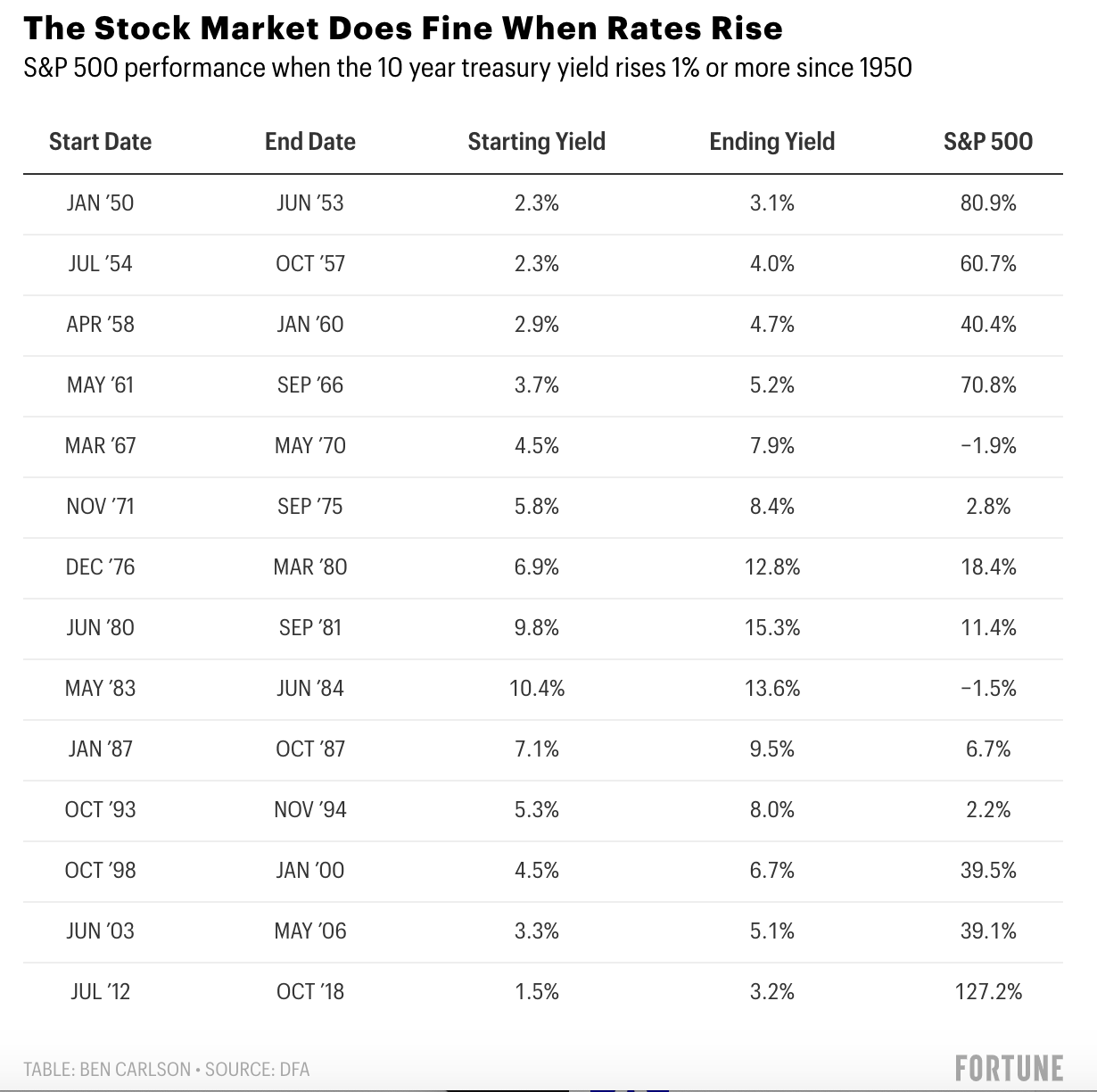在新冠疫情的前半階段,利率一直在做單向運動——下滑。于去年夏末降至0.5%的最低點之后,10年期國債收益率終于迎來了高漲。
沒有人知道利率上漲的具體原因是什么,但隨著人們看到疫情盡頭的曙光,通脹預期開始抬頭。如果利率的上漲是因為投資者預計未來的經濟增速會更高,那這肯定是件好事情。

但投資者始終會擔心風險,而且有人擔心利率的此次上揚可能會讓股市脫軌。這里當然存在這種可能性,但歷史告訴我們,股市在利率上漲的環境中總是處變不驚。
我回顧了自1950年以來每一次10年期國債收益率漲幅不低于1%時,美國股市在債券收益率上漲后的表現:

在利率上漲的環境下,股市下跌的情形僅出現過兩次。事實上,股市在這些時期(利率增長1%或以上)的年化回報率為10.5%,基本上就是美國股市長期回報的平均水平。
值得注意的是,其中的一些利率增長時段確實出現在一些股市暴跌之前。1987年的利率上漲之后,股市在當年10月出現了歷史上最大的單日跌幅。利率在20世紀90年代末互聯網泡沫的最后幾年中出現了上漲,當時美聯儲(Federal Reserve)正嘗試消除股市瘋狂的投機情緒。最終,美聯儲的舉措奏效了,股市跌幅高達50%。
然而,我們確實不知道利率要達到哪個臨界線才會讓投資者認為事情已經失去了控制。這里的標準確實不好把握,更多的是對心態的考驗。
如果上漲的利率并非是投資者在當前環境中需要擔心的因素,那么我們應該關注什么?
通脹就比利率水平重要的多。
自1928年以來,美國平均年化通脹率剛好在3%左右。基于標普500指數(S&P 500)在這個時期的平均回報,股市希望通脹率能夠保持在這一水平之下,而且是只降不升。

多年來,在通脹率上升之際,股市平均年化回報率增長了6.7%,然而在通脹下跌時期,股市的平均年化回報接近17%。當我們審視某一年到下一年的通脹時,年化回報也會出現類似的現象。在歷史上,當通脹高于上一年時,股市的平均回報率為6.3%,但當通脹出現同比下降時,股市的年化回報率接近16%。
如今,按照歷史標準來看,通脹水平依然處于低位,同比增幅為1.4%。但通脹預期(按照5年期盈虧平衡通脹率計算)如今處于2013年以來的最高水平,達到了2.4%。然而這個數字依然低于長期平均水平,而且實際結果通常難以與預期完全吻合。
不斷上升的利率和通脹預期對經濟來說是個好消息。其中每個變量都可能會被疫情結束所帶領的經濟增長以及隨之引發的消費者支出反彈而消化。
但是,投資者需要注意其中可能存在的潛在風險。當股市在去年疲軟的經濟環境中依然風生水起時,人們感覺并沒有多大的風險。如果股市在今年不斷提振的經濟中略有停滯,人們也可能會有同樣的感覺。然而這就是股市的運行方式,而且其當前的表現并不一定合乎情理。(財富中文網)
本文作者本·卡爾森(Ben Carlson)是里薩茲財富管理公司(Ritholtz Wealth Management)機構資產管理部門的主任。作者可能持有文中提及的證券或資產。
譯者:馮豐
審校:夏林
在新冠疫情的前半階段,利率一直在做單向運動——下滑。于去年夏末降至0.5%的最低點之后,10年期國債收益率終于迎來了高漲。
沒有人知道利率上漲的具體原因是什么,但隨著人們看到疫情盡頭的曙光,通脹預期開始抬頭。如果利率的上漲是因為投資者預計未來的經濟增速會更高,那這肯定是件好事情。
但投資者始終會擔心風險,而且有人擔心利率的此次上揚可能會讓股市脫軌。這里當然存在這種可能性,但歷史告訴我們,股市在利率上漲的環境中總是處變不驚。
我回顧了自1950年以來每一次10年期國債收益率漲幅不低于1%時,美國股市在債券收益率上漲后的表現:
在利率上漲的環境下,股市下跌的情形僅出現過兩次。事實上,股市在這些時期(利率增長1%或以上)的年化回報率為10.5%,基本上就是美國股市長期回報的平均水平。
值得注意的是,其中的一些利率增長時段確實出現在一些股市暴跌之前。1987年的利率上漲之后,股市在當年10月出現了歷史上最大的單日跌幅。利率在20世紀90年代末互聯網泡沫的最后幾年中出現了上漲,當時美聯儲(Federal Reserve)正嘗試消除股市瘋狂的投機情緒。最終,美聯儲的舉措奏效了,股市跌幅高達50%。
然而,我們確實不知道利率要達到哪個臨界線才會讓投資者認為事情已經失去了控制。這里的標準確實不好把握,更多的是對心態的考驗。
如果上漲的利率并非是投資者在當前環境中需要擔心的因素,那么我們應該關注什么?
通脹就比利率水平重要的多。
自1928年以來,美國平均年化通脹率剛好在3%左右。基于標普500指數(S&P 500)在這個時期的平均回報,股市希望通脹率能夠保持在這一水平之下,而且是只降不升。
多年來,在通脹率上升之際,股市平均年化回報率增長了6.7%,然而在通脹下跌時期,股市的平均年化回報接近17%。當我們審視某一年到下一年的通脹時,年化回報也會出現類似的現象。在歷史上,當通脹高于上一年時,股市的平均回報率為6.3%,但當通脹出現同比下降時,股市的年化回報率接近16%。
如今,按照歷史標準來看,通脹水平依然處于低位,同比增幅為1.4%。但通脹預期(按照5年期盈虧平衡通脹率計算)如今處于2013年以來的最高水平,達到了2.4%。然而這個數字依然低于長期平均水平,而且實際結果通常難以與預期完全吻合。
不斷上升的利率和通脹預期對經濟來說是個好消息。其中每個變量都可能會被疫情結束所帶領的經濟增長以及隨之引發的消費者支出反彈而消化。
但是,投資者需要注意其中可能存在的潛在風險。當股市在去年疲軟的經濟環境中依然風生水起時,人們感覺并沒有多大的風險。如果股市在今年不斷提振的經濟中略有停滯,人們也可能會有同樣的感覺。然而這就是股市的運行方式,而且其當前的表現并不一定合乎情理。(財富中文網)
本文作者本·卡爾森(Ben Carlson)是里薩茲財富管理公司(Ritholtz Wealth Management)機構資產管理部門的主任。作者可能持有文中提及的證券或資產。
譯者:馮豐
審校:夏林
Throughout the first half of the pandemic, interest rates went in one direction—down. After bottoming out at 0.5% toward the end of the summer, 10-year Treasury yields are finally on the upswing.
No one knows the precise reason for the increase in rates, but inflation expectations are rising now that there is light at the end of the tunnel for the pandemic. When rates are rising because investors expect economic growth to be higher in the future, that’s a good thing.
But investors always worry about risk, and there is fear this rise in rates could derail the stock market. That is certainly possible, but history shows the stock market holds up well in rising rate environments.
I went back to 1950 to find each instance where the 10-year Treasury yield rose by 1% or more to see how U.S. stocks performed when bond yields were moving higher:
There have only been two instances where stocks fell during a rising rate environment. In fact, the annualized returns in each of these periods where rates rose 1% or more was 10.5%, which is right around the average long-term return for the U.S. stock market.
It is worth noting some of these rising rate environments did precede some nasty stock market falls. Rates raced higher in 1987 right before the biggest one-day crash in history in October of that year. And rates rose in the final couple of years in the late-1990s dotcom bubble as the Fed was trying to snuff out a speculative mania. Eventually, it worked, and stocks got cut in half.
But we certainly don’t know the exact level of rates in which investors would determine things have gotten out of hand. There is no line in the sand on these things. It’s more of an exercise in psychology than anything.
So if it’s not rising interest rates investors need to worry about in the current environment then what should you be looking for?
Inflation is far more important to stocks than interest rate levels.
Since 1928, the average annual inflation rate in the United States is right around 3%. Based on the average returns for the S&P 500 in that time, the stock market would prefer the inflation rate stays below that level and that it’s falling not rising.
The average annual return for years in which the inflation rate is rising saw stocks up 6.7%, while the average annual return when inflation is falling was nearly 17%. A similar relationship exists when looking at inflation from one year to the next. Historically, when inflation has been higher than the previous year, stocks have returned an average of 6.3% against an average annual return of almost 16% when the inflation rate is down year over year.
Inflation is still quite low by historical standards today, at around 1.4% over the past year. But inflation expectations, as measured by the five-year break-even inflation rate, are now at their highest level since 2013 at 2.4%. That's still below the long-term average, and actual results don’t always line up perfectly with expectations.
Rising interest rates and inflation expectations are a good thing for the economy. Each of these variables is pricing in higher economic growth from the potential end of the pandemic and the ensuing spending boom it could bring about from consumers.
But investors need to be aware of the potential risks involved as well. It felt backward when the stock market was doing so well in the face of a weakening economy last year. It may feel equally backward if the stock market pauses for a bit in the face of a strengthening economy this year. Yet this is how the stock market works, and it doesn’t always make sense in the moment.
Ben Carlson is the director of institutional asset management at Ritholtz Wealth Management. He may own securities or assets discussed in this piece.






